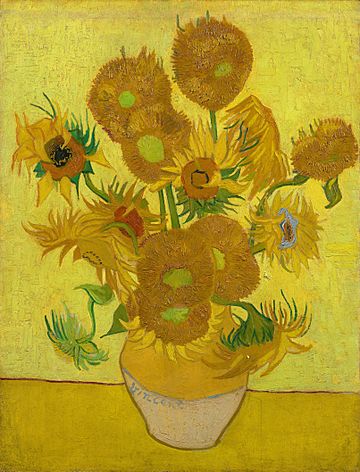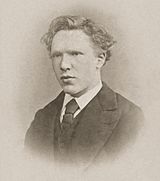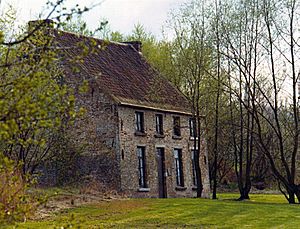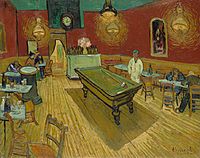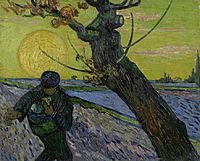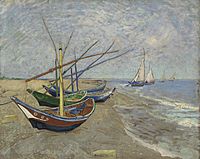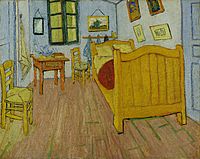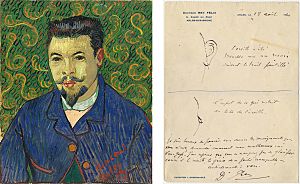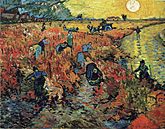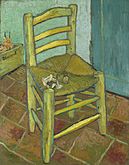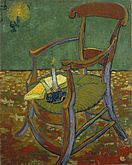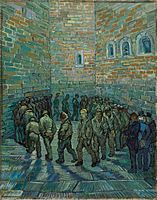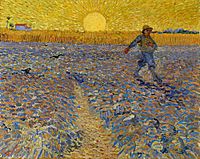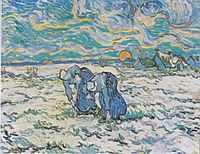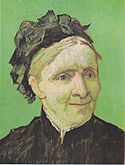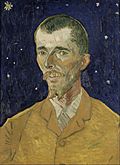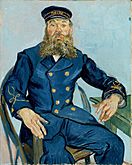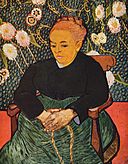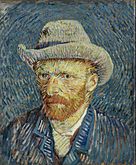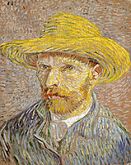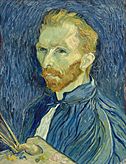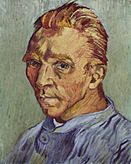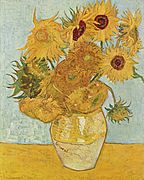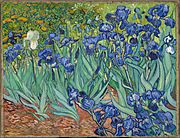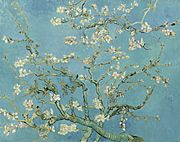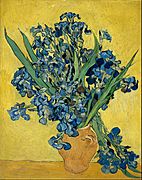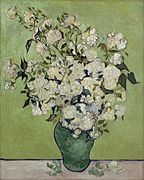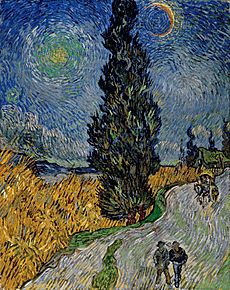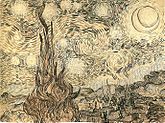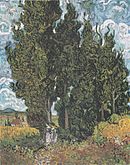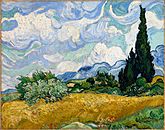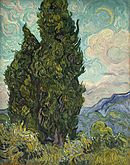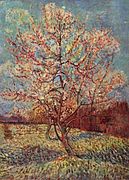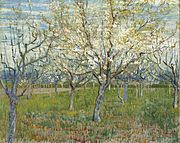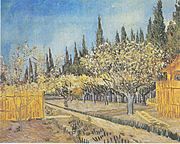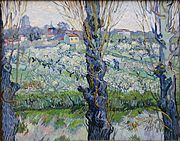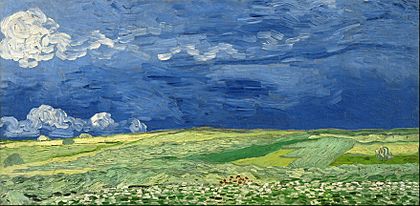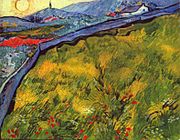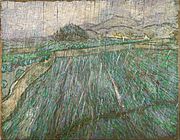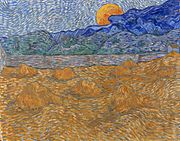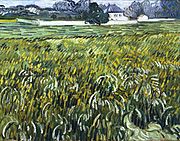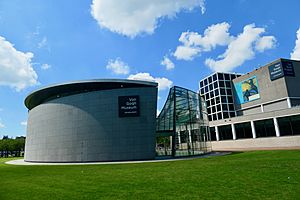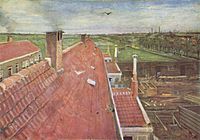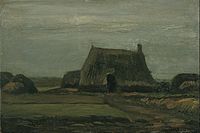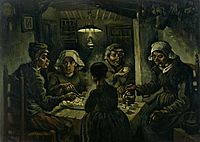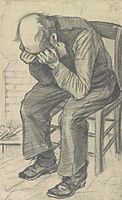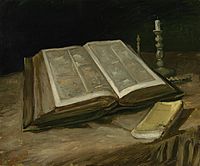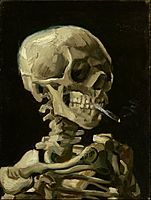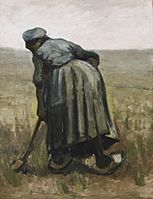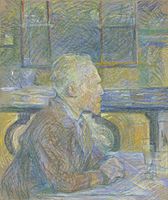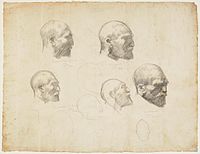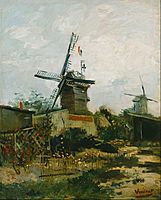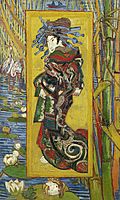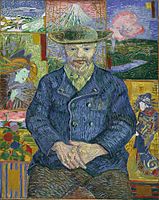Vincent van Gogh facts for kids
Quick facts for kids
Vincent van Gogh
|
|
|---|---|
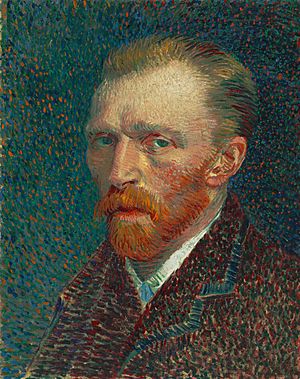
Self-Portrait, 1887, Art Institute of Chicago
|
|
| Born |
Vincent Willem van Gogh
30 March 1853 Zundert, Netherlands
|
| Died | 29 July 1890 (aged 37) Auvers-sur-Oise, France
|
| Education |
|
|
Notable work
|
|
| Movement | Post-Impressionism |
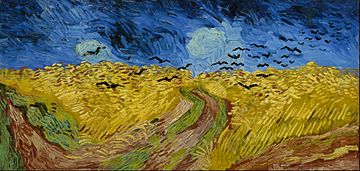
Vincent Willem van Gogh (Dutch: [ˈvɪnsɛnt ˈʋɪləm vɑŋ ˈɣɔx] (![]() listen); 30 March 1853 – 29 July 1890) was a Dutch Post-Impressionist painter who posthumously became one of the most famous and influential figures in Western art history. Not commercially successful in his career, he struggled with severe depression and poverty, factors which precipitated his death in 1890, at age of thirty-seven.
listen); 30 March 1853 – 29 July 1890) was a Dutch Post-Impressionist painter who posthumously became one of the most famous and influential figures in Western art history. Not commercially successful in his career, he struggled with severe depression and poverty, factors which precipitated his death in 1890, at age of thirty-seven.
Contents
Early years
Vincent Willem van Gogh was born on 30 March 1853 in Groot-Zundert, in the predominantly Catholic province of North Brabant in the Netherlands. He was the oldest surviving child of Theodorus van Gogh (1822–1885), a minister of the Dutch Reformed Church, and his wife, Anna Cornelia Carbentus (1819–1907), who came form a prosperous family in The Hague.
Van Gogh's parents married in May 1851, and moved to Zundert. His brother Theo was born on 1 May 1857. There was another brother, Cor, and three sisters: Elisabeth, Anna, and Willemina (known as "Wil"). In later life, Van Gogh remained in touch only with Willemina and Theo.
His father's salary as a minister was modest, but the Church also supplied the family with a house, a maid, two cooks, a gardener, a carriage and horse; his mother Anna instilled in the children a duty to uphold the family's high social position.
Van Gogh was a serious and thoughtful child. He was taught at home by his mother and a governess, and in 1860, was sent to the village school. In 1864, he was placed in a boarding school at Zevenbergen, where he felt abandoned, and he campaigned to come home. Instead, in 1866, his parents sent him to the middle school in Tilburg, where he was also deeply unhappy.
His interest in art began at a young age. He was encouraged to draw as a child by his mother, and his early drawings are expressive, but do not approach the intensity of his later work. He had art classes at Tilburg, but his teacher's philosophy was to reject technique in favour of capturing the impressions of things, so the lessons had little effect.
Early career
In March 1868, Van Gouh returned home. In July 1869, Van Gogh's uncle Cent obtained a position for him at the art dealers Goupil & Cie in The Hague. After completing his training in 1873, he was transferred to Goupil's London branch on Southampton Street, and took lodgings at 87 Hackford Road, Stockwell. This was a happy time for Van Gogh; he was successful at work and, at 20, was earning more than his father. Theo's wife, Jo Van Gogh-Bonger, later remarked that this was the best year of Vincent's life.
Before taking up arts professionally, Van Gogh had changed jobs and interests. He worked as a supply teacher in a small boarding school in Ramsgate, was a Methodist minister's assistant, and wanted to become a pastor. In 1878, Van Gogh prepared for the University of Amsterdam theology entrance examination, but failed it.
In January 1879, he took up a post as a missionary at Petit-Wasmes in the working class, coal-mining district of Borinage in Belgium. To show support for his impoverished congregation, he gave up his comfortable lodgings at a bakery to a homeless person and moved to a small hut, where he slept on straw. His parents were worried about him and even considered sending him to a lunatic asylum.
Artistic education
In 1880, his brother Theo advised him to take up art seriously. In November 1880, he registered at the Académie Royale des Beaux-Arts, where he studied anatomy and the standard rules of modelling and perspective.
He decided to contunue formal education in 1886. Despite his antipathy towards academic teaching, he took the higher-level admission exams at the Academy of Fine Arts in Antwerp and, in January 1886, matriculated in painting and drawing. He became ill and run down by overwork, poor diet and excessive smoking. He started to attend drawing classes after plaster models at the Antwerp Academy on 18 January 1886.
At the Antwerp Academy, he quickly got into trouble with Charles Verlat, the director of the academy and teacher of a painting class, because of his unconventional painting style. He also confornted other professors and eventually left the Academy.
Artistic breakthrough
Suffering from smoker's cough, in February 1888 Van Gogh sought refuge in Arles.
The time in Arles became one of Van Gogh's more prolific periods: he completed 200 paintings and more than 100 drawings and watercolours. He was enchanted by the local countryside and light; his works from this period are rich in yellow, ultramarine and mauve. They include harvests, wheat fields and general rural landmarks from the area, including The Old Mill (1888).
In March 1888 he painted landscapes using a gridded "perspective frame"; three of the works were shown at the annual exhibition of the Société des Artistes Indépendants. In April, he was visited by the American artist Dodge MacKnight, who was living nearby at Fontvieille. On 1 May 1888, for 15 francs per month, he signed a lease for the eastern wing of the Yellow House at 2 place Lamartine. The rooms were unfurnished and had been uninhabited for months.
The Yellow House had to be furnished before he could fully move in, but he was able to use it as a studio. He wanted a gallery to display his work and started a series of paintings that eventually included Van Gogh's Chair (1888), Bedroom in Arles (1888), The Night Café (1888), Café Terrace at Night (September 1888), Starry Night Over the Rhone (1888), and Still Life: Vase with Twelve Sunflowers (1888), all intended for the decoration for the Yellow House.
Van Gogh wrote that with The Night Café he tried "to express the idea that the café is a place where one can ruin oneself, go mad, or commit a crime".
-
The Old Mill, 1888. Albright–Knox Art Gallery, Buffalo, New York
Friendship with Paul Gauguin

When living in Paris in 1886-1888, Van Gogh met many impressionists, including Paul Gauguin. Van Gogh invited Gauguin to stay and to work with him in Arles.
When Gauguin agreed to visit Arles in 1888, Van Gogh hoped for friendship and to realize his idea of an artists' collective. Van Gogh prepared for Gauguin's arrival by painting four versions of Sunflowers in one week. "In the hope of living in a studio of our own with Gauguin," he wrote in a letter to Theo, "I’d like to do a decoration for the studio. Nothing but large Sunflowers."
After much pleading from Van Gogh, Gauguin arrived in Arles on 23 October and, in November, the two painted together. Gauguin depicted Van Gogh in his The Painter of Sunflowers; Van Gogh painted pictures from memory, following Gauguin's suggestion. Among these "imaginative" paintings is Memory of the Garden at Etten. Their first joint outdoor venture was at the Alyscamps, when they produced the pendants Les Alyscamps. The single painting Gauguin completed during his visit was his portrait of Van Gogh.
Van Gogh admired Gauguin and wanted to be treated as his equal, but Gauguin was arrogant and domineering, which frustrated Van Gogh. Their relationship began to deteriorate. They often quarrelled; Van Gogh increasingly feared that Gauguin was going to desert him, and the situation, which Van Gogh described as one of "excessive tension", rapidly headed towards crisis point.
After an altercation with Gauguin on the evening of 23 December 1888, Van Gogh returned to his room where he severed his left ear. He bandaged the wound, wrapped the ear in paper and delivered the package to a place Van Gogh and Gauguin both frequented.
Van Gogh was found unconscious the next morning by a policeman and taken to hospital, where he was treated by Félix Rey, a young doctor still in training. The ear was brought to the hospital, but Rey did not attempt to reattach it as too much time had passed.
Gauguin fled Arles, never to see Van Gogh again. However, they continued to correspond.
In 1889, Van Gogh gave his Portrait of Doctor Félix Rey to Dr Rey. The physician was not fond of the painting and used it to repair a chicken coop, then gave it away. In 2016, the portrait was housed at the Pushkin Museum of Fine Arts and estimated to be worth over $50 million.
-
The Red Vineyard, November 1888. Pushkin Museum, Moscow. Sold to Anna Boch, 1890
-
Van Gogh's Chair, 1888. National Gallery, London
Deteriorating health and recognition
Van Gogh often neglected his physical health. He suffered from psychotic episodes and delusions. After the incident with the cut-off ear, he spent time in psychiatric hospitals, including a period at Saint-Rémy.
At Saint-Rémy, Van Gogh had two cells with barred windows, one of which he used as a studio. The clinic and its garden became the main subjects of his paintings. He made several studies of the hospital's interiors, such as Vestibule of the Asylum and Saint-Rémy (September 1889), and its gardens, such as Lilacs (May 1889). Some of his works from this time are characterised by swirls, such as The Starry Night.
He was allowed short supervised walks, during which time he painted cypresses and olive trees, including Valley with Ploughman Seen from Above, Olive Trees with the Alpilles in the Background 1889, Cypresses 1889, Cornfield with Cypresses (1889), Country road in Provence by Night (1890). In September 1889, he produced two further versions of Bedroom in Arles and The Gardener.
From 20 March to 27 April 1890, Van Gogh was included in the sixth exhibition of the Société des Artistes Indépendants in the Pavillon de la Ville de Paris on the Champs-Elysées. Van Gogh exhibited ten paintings. While Van Gogh's exhibit was on display with the Artistes Indépendants in Paris, Claude Monet said that his work was the best in the show.
-
The Sower (after Jean-François Millet), 1888. Kröller-Müller Museum, Otterlo
-
Two Peasant Women Digging in a Snow-Covered Field at Sunset (after Jean-François Millet), 1890. Foundation E.G. Bührle Collection, Zurich, Switzerland
Death
In May 1890, Van Gogh left the clinic in Saint-Rémy to move nearer to both Dr Paul Gachet in the Paris suburb of Auvers-sur-Oise and to Theo. Gachet was an amateur painter and had treated several other artists – Camille Pissarro had recommended him.
His depression persisted, and on 27 July 1890, Van Gogh is believed to have shot himself in the chest with a revolver, dying from his injuries two days later.
Van Gogh was buried on 30 July, in the municipal cemetery of Auvers-sur-Oise. The funeral was attended by Theo van Gogh, Andries Bonger, Charles Laval, Lucien Pissarro, Émile Bernard, Julien Tanguy and Paul Gachet, among twenty family members, friends and locals.
The gun Van Gogh was reputed to have used was rediscovered in 1965 and was auctioned, on 19 June 2019, as "the most famous weapon in art history". The gun sold for €162,500 (£144,000; $182,000), almost three times more than expected.
Personal life
Van Gough proposed to several women but was rejected. Unlucky in love, he never married or had children.
Interesting facts about Vincent van Gogh
- Van Gogh was given the name of his grandfather and of a brother stillborn exactly a year before his birth. Vincent was a common name in the Van Gogh family.
- His grandfather, also Vincent (1789–1874), was the prominent art dealer, and a theology graduate at the University of Leiden in 1811. This Vincent had six sons, three of whom became art dealers, and may have been named after his own great-uncle, a sculptor (1729–1802).
- He was a very prolific artist. In a decade, he created about 2,100 artworks, including around 860 oil paintings, most of which date from the last two years of his life.
- The most comprehensive primary source on Van Gogh is the correspondence between him and his younger brother, Theo who was an art dealer. Their lifelong friendship, and most of what is known of Vincent's thoughts and theories of art, are recorded in the hundreds of letters they exchanged from 1872 until 1890.
- Theo van Gogh provided his brother with financial and emotional support as well as access to influential people on the contemporary art scene.
- Theo named his son Vincent, after his brother.
- Minor planet 4457 van Gogh is named in his honour.
Vincent van Gogh quotes
- “It is good to love many things, for therein lies the true strength, and whosoever loves much performs much, and can accomplish much, and what is done in love is well done.”
- “I dream my painting and I paint my dream.”
- “A great fire burns within me, but no one stops to warm themselves at it, and passers-by only see a wisp of smoke.”
- “Normality is a paved road: It’s comfortable to walk, but no flowers grow on it.”
- “What would life be if we had no courage to attempt anything?”
Major series
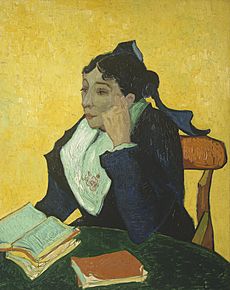
Van Gogh's stylistic developments are usually linked to the periods he spent living in different places across Europe. He was inclined to immerse himself in local cultures and lighting conditions, although he maintained a highly individual visual outlook throughout. His evolution as an artist was slow, and he was aware of his painterly limitations.
Portraits
Van Gogh said portaiture was his greatest interest. He wrote to his sister that he wished to paint portraits that would endure, and that he would use colour to capture their emotions and character rather than aiming for photographic realism. Those closest to Van Gogh are mostly absent from his portraits; he rarely painted Theo, Van Rappard or Bernard. The portraits of his mother were from photographs.
Van Gogh painted Arles' postmaster Joseph Roulin and his family repeatedly. In five versions of La Berceuse (The Lullaby), Van Gogh painted Augustine Roulin quietly holding a rope that rocks the unseen cradle of her infant daughter. Van Gogh had planned for it to be the central image of a triptych, flanked by paintings of sunflowers.
-
Eugène Boch (The Poet Against a Starry Sky), 1888, Musée d'Orsay, Paris
-
Portrait of the Postman Joseph Roulin (1841–1903), early August 1888, Museum of Fine Arts, Boston
Self-portraits
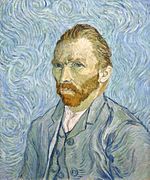
Van Gogh created more than 43 self-portraits between 1885 and 1889. They were usually completed in series, such as those painted in Paris in mid-1887, and continued until shortly before his death. Generally the portraits were studies, created during periods when he was reluctant to mix with others, or when he lacked models, and so painted himself.
Van Gogh's self-portraits vary stylistically. In those painted after December 1888, the strong contrast of vivid colors highlight the haggard pallor of his skin. Some depict the artist with a beard, others without. He can be seen with bandages in portraits executed just after he mutilated his ear. In only a few does he depict himself as a painter. Those painted in Saint-Rémy show the head from the right, the side opposite his damaged ear, as he painted himself reflected in his mirror.
-
Self-Portrait, 1889. National Gallery of Art, Washington, D.C. His Saint-Rémy self-portraits show his side with the unmutilated ear, as he saw himself in the mirror
Flowers
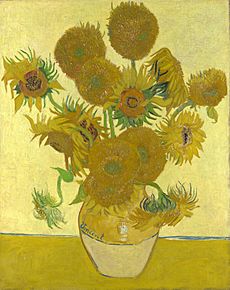
Van Gogh painted several landscapes with flowers, including roses, lilacs, irises, and sunflowers. Some reflect his interests in the language of colour, and also in Japanese ukiyo-e. There are two series of dying sunflowers. The first was painted in Paris in 1887 and shows flowers lying on the ground. The second set was completed a year later in Arles and is of bouquets in a vase positioned in early morning light.
The sunflowers were painted to decorate the walls in anticipation of Gauguin's visit, and Van Gogh placed individual works around the Yellow House's guest room in Arles. Gauguin was deeply impressed and later acquired two of the Paris versions. After Gauguin's departure, Van Gogh imagined the two major versions of the sunflowers as wings of the Berceuse Triptych, and included them in his Les XX in Brussels exhibit. Today the major pieces of the series are among his best known, celebrated for the sickly connotations of the colour yellow and its tie-in with the Yellow House, the expressionism of the brush strokes, and their contrast against often dark backgrounds.
Cypresses and olives
Fifteen canvases depict cypresses, a tree he became fascinated with in Arles. He brought life to the trees, which were traditionally seen as emblematic of death. While in Saint-Rémy, Van Gogh spent time outside the asylum, where he painted trees in the olive groves.
-
Cypresses in Starry Night, a reed pen drawing executed by Van Gogh after the painting in 1889.
Orchards
The Flowering Orchards (also the Orchards in Blossom) are among the first groups of work completed after Van Gogh's arrival in Arles in February 1888. The 14 paintings are optimistic, joyous and visually expressive of the burgeoning spring. They are delicately sensitive and unpopulated. He painted swiftly, and although he brought to this series a version of Impressionism, a strong sense of personal style began to emerge during this period.
Van Gogh was enthralled by the landscape and vegetation of the south of France, and often visited the farm gardens near Arles. In the vivid light of the Mediterranean climate his palette significantly brightened.
Wheat fields
Van Gogh made several painting excursions during visits to the landscape around Arles. He made paintings of harvests, wheat fields and other rural landmarks of the area, including The Old Mill (1888); a good example of a picturesque structure bordering the wheat fields beyond. At various points, Van Gogh painted the view from his window – at The Hague, Antwerp, and Paris. These works culminated in The Wheat Field series, which depicted the view from his cells in the asylum at Saint-Rémy.
Van Gogh was captivated by the fields in May when the wheat was young and green. His Wheatfields at Auvers with White House shows a more subdued palette of yellows and blues, which creates a sense of idyllic harmony.
-
Rain or Enclosed Wheat Field in the Rain, November 1889, Philadelphia Museum of Art, Philadelphia
-
Wheat Field at Auvers with White House, June 1890, The Phillips Collection, Washington D.C.
Van Gogh Museum
Van Gogh's nephew and namesake, Vincent Willem van Gogh (1890–1978), inherited the estate after his mother's death in 1925. During the early 1950s he arranged for the publication of a complete edition of the letters presented in four volumes and several languages. He then began negotiations with the Dutch government to subsidise a foundation to purchase and house the entire collection. Theo's son participated in planning the project in the hope that the works would be exhibited under the best possible conditions. The project began in 1963; architect Gerrit Rietveld was commissioned to design it, and after his death in 1964 Kisho Kurokawa took charge. Work progressed throughout the 1960s, with 1972 as the target for its grand opening.
The Van Gogh Museum opened in the Museumplein in Amsterdam in 1973. It became the second most popular museum in the Netherlands, after the Rijksmuseum, regularly receiving more than 1.5 million visitors a year. In 2015 it had a record 1.9 million. Eighty-five percent of the visitors come from other countries.
Nazi-looted art
During the Nazi period (1933–1945) a great number of artworks by Van Gogh changed hands. Some of these works have disappeared into private collections. Others have since resurfaced in museums, or at auction, or have been reclaimed, often in high-profile lawsuits, by their former owners. The German Lost Art Foundation still lists dozens of missing van Goghs and the American Alliance of Museums lists 73 van Goghs on the Nazi Era Provenance Internet Portal.
Images for kids
-
The Potato Eaters, 1885. Van Gogh Museum, Amsterdam
-
Peasant Woman Digging, or Woman with a Spade, Seen from Behind, 1885. Art Gallery of Ontario, Toronto
-
Henri de Toulouse-Lautrec, Portrait of Vincent van Gogh, 1887, pastel drawing, Van Gogh Museum, Amsterdam
-
John Russell drew these five studies of Van Gogh a year or so after painting his 1886 portrait (studies, Art Gallery of New South Wales, Sydney)
-
Le Moulin de Blute-Fin (1886) from the Le Moulin de la Galette and Montmartre series'. Bridgestone Museum of Art, Tokyo (F273)
See also
 In Spanish: Vincent van Gogh para niños
In Spanish: Vincent van Gogh para niños


